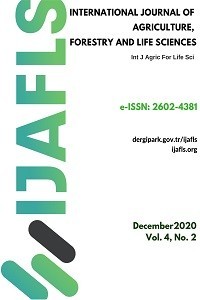EXAMINING THE FINANCIAL PERFORMANCE OF PRIMARY AGRICULTURAL COOPERATIVES IN DINSHO DISTRICT OF BALE ZONE OF ETHIOPIA
EXAMINING THE FINANCIAL PERFORMANCE OF PRIMARY AGRICULTURAL COOPERATIVES IN DINSHO DISTRICT OF BALE ZONE OF ETHIOPIA
Cooperatives liquidity ratio, financial leverage management ration and profitability ratio,
___
- Bernard, T., G.T. Abate and S. Lemma. 2013. Agricultural Cooperatives in Ethiopia: Results of The 2012 ATA Baseline Survey. Washington (DC): International Food Policy Res. Retrieved from http://ebrary.ifpri.org/cdm/ref/collection/p15738coll2/id/127690
- Dagne M., T. Degefa and C. Fischer, 2017: The Development of Agricultural Cooperatives in Ethiopia: History and a Framework for Future Trajectory. ejossah.V.13. i.1.3. https://www.researchgate.net/publication/322202824
- Dinsho district cooperatives offices, 2017/18. Report of the performance of cooperatives, unpublished documents.
- Emana, B. 2012. Cooperative movement in Ethiopia (a Paper Presented at Workshop on Perspectives for Cooperatives in Eastern Africa) Uganda: Kampala.
- Emana, B., M. Nigussie. 2011. Strategizing Cooperative Development in Ethiopia. (An Unpublished Report Submitted to Agricultural Transformation Agency (ATA)). Addis Ababa, Ethiopia.
- Federal Cooperative Agency (FCA). 2014. Cooperatives. Annual publication 1(11), Addis Ababa: FCA.
- Federal Democratic Republic of Ethiopia (FDRE), 2002. Ethiopia: Sustainable development andpoverty reduction program. Addis Ababa, Ethiopia.Ministry of Agriculture (MoA), Federal Democratic Republic of Ethiopia (2012). Agricultural Cooperatives Sector Development Strategy 2012-2016. Retrieved from: http://www.ata.gov.et/news/resources/sector-strategies/
- Ministry of Finance and Economic Development (MoFED) (2013). Annual progress Report of the GTP (Growth and Transformation Plan). https://info.undp.org/docs/pdc/Documents/ETH/2014 0331_DAG_Annual_Progress_Report_%202013%20(2).pdf -Wanyama, F.O. 2014.Cooperatives and the Sustainable Development Goals: A Contribution to the Post-2015 Development Debate. Geneva (Switzerland): ILO.World Bank (2006). Managing water resources to maximize sustainable growth. A World Bank water resources assistance strategy for Ethiopia: The World Bank Agriculture and Rural Development Department. Report No. 36000-ET. Washington, DC, USA.https://siteresources.worldbank.org/.../Resources/Ethiopia_final_text_ and_cover.pdf.
- USAID, 2015/16: Identifying Processes and Policies Conducive to Cooperative Development in Africa Ethiopia Country Report
- Abate, G., Francesconi, G.N. & Getnet, K. (2014). Impact of agricultural cooperatives on smallholders’ technical efficiency: empirical evidence from Ethiopia. Annals of Publicand Cooperative Economics 85:2 257-286
- Marwa, N.W. & Aziakpono, M.J. (2015). Technical and scale efficiency of saving and creditcooperatives in Tanzania. ERSA Working Paper # 510.
- Sathyamoorthi C R, Christian J. Mbekomize, Ishmael Radikoko & Lillian Wally-Dima, 2016: An Analysis of the Financial Performance of Selected Savings and Credit Co-Operative Societies in Botswana. International Journal of Economics and Finance; Vol. 8, No. 8; 2016, doi:10.5539/ijef.v8n8p180: URL: http://dx.doi.org/10.5539/ijef.v8n8p180
- Alema Weldemariam, (2008) Analysis of the Role of Cooperatives in Agricultural Input and output marketing in Southern Zone of Tigray, Ethiopia
- Russell L. Alan, 2013: Cost Efficiency And Capital Structure In Farms And Cooperatives An Abstract Of A Dissertation Submitted In Partial Fulfillment Of The Requirements For The Degree Doctor Of Philosophy Department Of Agricultural Economics.
- Omid Sharifi, 2013: Financial Management And Ratio Analysis For Agricultural Cooperatives, G.J. C.M.P., Vol. 2(4):127-133
- Lakew, T. B., Meniga, M., & Gebru, A. (2014). A study on financial performance of multipurpose co-operative unions in Tigray Region, Ethiopia. International Journal of Current Research, 6(11), 9810-9815.
- Yayın Aralığı: Yılda 2 Sayı
- Başlangıç: 2017
- Yayıncı: Volkan OKATAN
İlker SÖNMEZ, Hüseyin KALKAN, Halil DEMİR, Recep KÜLCÜ, Osman YALDIZ, Mustafa KAPLAN
Medhat Mikhail TAWFİK, Elham BADR, Alice Tawfik TALOOTH
DETERMINATION OF SUITABLE AREAS OF APPLE (MALUS DOMESTICA) CULTIVATION WITH AHP AND GIS TECHNIQUES
Namık Kemal SÖNMEZ, Sahriye SÖNMEZ, Mesut ÇOŞLU, Hasan Raşit TÜRKKAN
AGRICULTURAL DEVELOPMENT LED INDUSTRIALIZATION IN ETHIOPIA: STRUCTURAL BREAK ANALYSIS
Ahmed Kasim DUBE, Wasiu Olayinka FAWOLE, Ramu GOVİNDASAMY, Burhan ÖZKAN
Catherine ARRADAZA, Ma. Lourdes O. CEDO, Rocelie R. ZARA, Rachel Ann GONZAGA
INVESTIGATIONS ON SOME PROPERTIES OF CURRANT AND GOOSEBERRY VARIETIES GROWN IN ORGANIC CONDITION
